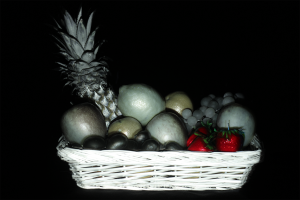Group 1: Giacomo, Robert

We decided to focus on the manipulation of the visual sensory input. We want to research how people react to optical changes to well-known objects.
The visual perception is characterized, by our ability to see different colors. So we decided to minipulate the colors on the objects, without having to physically interact with them.
By illuminating objects with a projector, we change their appearance. We chose to use a still life of a fruit basket as our object to be manipulated, because changing the color of for instance an apple to blue, will definitely catch the observers attention, whereas changing the color of a red mug to blue is not really interesting, because mugs don’t have a specific color.
Our still life is a basket filled with a pineapple, a citron, some strayberries, apples, clementines, grapes and chestnuts. By projecting a photo of the scene on itself, the saturation grows, by projecting it with complementary colors, it appears gray. Using a projector allows us to illuminate only a part of the scene with one color and the rest with the complementray color.
To catch the observers attention, we animate the colors. Our task is now to find out, what exactly catches attention.
Do slow animations of colors hold the observers attention? They might, because you could mistrust your visual sensory, when you see colors slightly changing, but aren’t really shure it really happened.
Can we catch attention by making fruits look more appetizing and how can we realise that? We can of course try exactly the opposite and make fruits look moldy.
 We decided to focus on the manipulation of the visual sensory input. We want to research how people react to optical changes to well-known objects.
The visual perception is characterized, by our ability to see different colors. So we decided to minipulate the colors on the objects, without having to physically interact with them.
By illuminating objects with a projector, we change their appearance. We chose to use a still life of a fruit basket as our object to be manipulated, because changing the color of for instance an apple to blue, will definitely catch the observers attention, whereas changing the color of a red mug to blue is not really interesting, because mugs don’t have a specific color.
Our still life is a basket filled with a pineapple, a citron, some strayberries, apples, clementines, grapes and chestnuts. By projecting a photo of the scene on itself, the saturation grows, by projecting it with complementary colors, it appears gray. Using a projector allows us to illuminate only a part of the scene with one color and the rest with the complementray color.
To catch the observers attention, we animate the colors. Our task is now to find out, what exactly catches attention.
Do slow animations of colors hold the observers attention? They might, because you could mistrust your visual sensory, when you see colors slightly changing, but aren’t really shure it really happened.
Can we catch attention by making fruits look more appetizing and how can we realise that? We can of course try exactly the opposite and make fruits look moldy.
We decided to focus on the manipulation of the visual sensory input. We want to research how people react to optical changes to well-known objects.
The visual perception is characterized, by our ability to see different colors. So we decided to minipulate the colors on the objects, without having to physically interact with them.
By illuminating objects with a projector, we change their appearance. We chose to use a still life of a fruit basket as our object to be manipulated, because changing the color of for instance an apple to blue, will definitely catch the observers attention, whereas changing the color of a red mug to blue is not really interesting, because mugs don’t have a specific color.
Our still life is a basket filled with a pineapple, a citron, some strayberries, apples, clementines, grapes and chestnuts. By projecting a photo of the scene on itself, the saturation grows, by projecting it with complementary colors, it appears gray. Using a projector allows us to illuminate only a part of the scene with one color and the rest with the complementray color.
To catch the observers attention, we animate the colors. Our task is now to find out, what exactly catches attention.
Do slow animations of colors hold the observers attention? They might, because you could mistrust your visual sensory, when you see colors slightly changing, but aren’t really shure it really happened.
Can we catch attention by making fruits look more appetizing and how can we realise that? We can of course try exactly the opposite and make fruits look moldy.